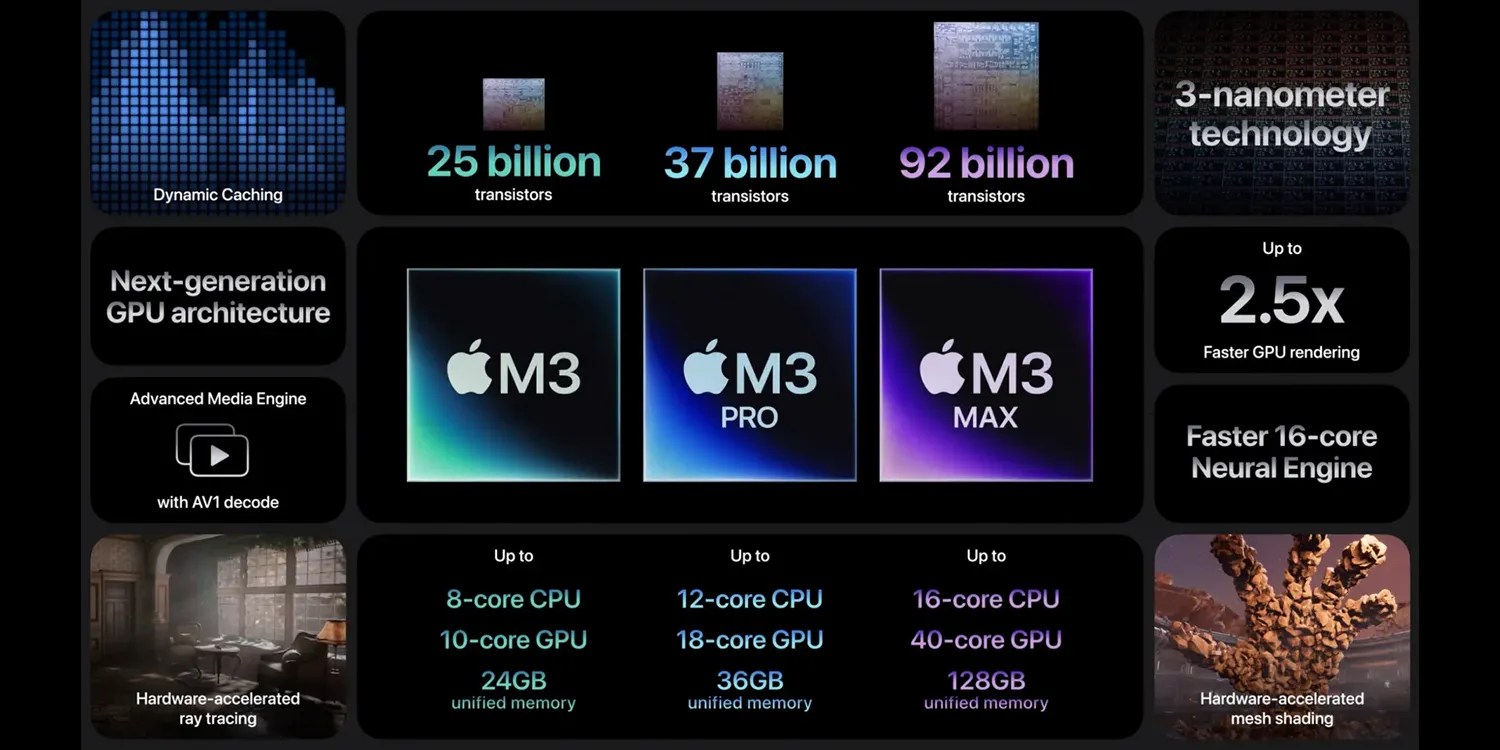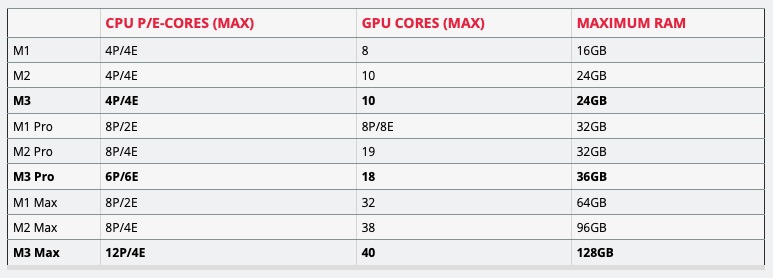
Apple of course used all the words and phrases you’d expect for the new M3 chip line-up: groundbreaking, dramatically increased performance, unleash new capabilities, the biggest leap forward, and so on.
The company also shared some graphs pointing to the improved performance of the 3nm based M3 chips compared to their predecessors …
Here’s a few edited highlights of what Apple had to say:
Apple today announced M3, M3 Pro, and M3 Max, three chips featuring groundbreaking technologies that deliver dramatically increased performance and unleash new capabilities for Mac. These are the first personal computer chips built using the industry-leading 3-nanometer process technology, allowing more transistors to be packed into a smaller space and improving speed and efficiency […]
The M3 family of chips features a next-generation GPU that represents the biggest leap forward in graphics architecture ever for Apple silicon. The GPU is faster and more efficient, and introduces a new technology called Dynamic Caching, while bringing new rendering features like hardware-accelerated ray tracing and mesh shading to Mac for the first time […]
“Apple silicon has completely redefined the Mac experience. Every aspect of its architecture is designed for performance and power efficiency,” said Johny Srouji, Apple’s senior vice president of Hardware Technologies. “With 3-nanometer technology, a next-generation GPU architecture, a higher-performance CPU, faster Neural Engine, and support for even more unified memory, M3, M3 Pro, and M3 Max are the most advanced chips ever built for a personal computer.”
Arstechnica dived beneath the hype to take a detailed look at how the M3 chip line-up stacks up against previous generations of Apple Silicon. This begins with a look at the specs:

The performance improvements of M3 over M2 are pretty much in line with the M2 over the M1.
Apple says that peak GPU performance for the M3 series is up to 65 percent faster than M1’s, though as with the CPU performance this will likely vary based on which chips you’re comparing. In our tests, the various M2-series GPUs are generally between 25 and 30 percent faster than their M1 equivalents, so the year-over-year performance increases from M1 to M2 to M3 are fairly even. Apple says that the M3’s rendering performance is up to 2.5 times faster than the M1 for workloads that take advantage of the new hardware acceleration features.
The M3 Pro doesn’t appear to get the same improvements as the base M3 and the M3 Max.
Compared to the M2, the plain-old M3 doesn’t get any additional cores, so it will rely solely on architectural improvements and clock speed bumps to increase performance—and it has 25 billion transistors, 5 billion more than M2, so there’s still quite a bit of new hardware here […]
The M3 Pro is a 37-billion transistor chip, which is 3 billion fewer than the M2 Pro. That makes sense once you look at the core counts; M2 Pro had eight performance cores and four efficiency cores, plus as many as 19 GPU cores. The M3 Pro still has 12 cores, but it’s split evenly between six performance cores and six efficiency cores, and the GPU tops out at 18 GPU cores. Maximum memory capacity does increase slightly, from 32GB to 36GB.
I still expect The M3 Pro to be an upgrade over the M2 Pro because of the updated architectures involved, but it looks like less of an upgrade than the M3 (which keeps core counts the same) or the M3 Max (which increases them). The M2 Pro and M2 Max used the same CPU core configuration, and my best guess is that the company wanted to create more of an incentive to jump from Pro to Max for people who don’t care about GPU performance.
As for the M3 Max, the 92 billion transistor count makes a huge jump from the M2 Max’s 67 billion. A lot of that is accounted for by the CPU M3 Max, which includes 12 performance cores and four efficiency cores, four more performance cores than the M2 Max. The GPU also gets a little bigger, jumping from a max of 38 cores to a max of 40. Maximum memory capacity also goes up from 96GB to 128GB.
We’ll of course learn much more about just how big an improvement the M3 chips offer once we start seeing benchmarks, and also reports of real-life use.
FTC: We use income earning auto affiliate links. More.





